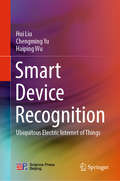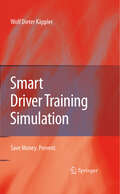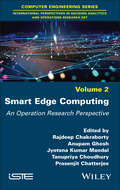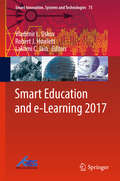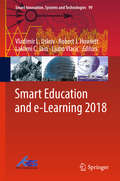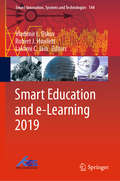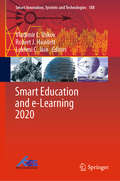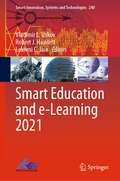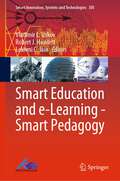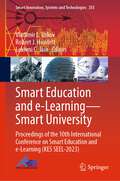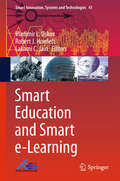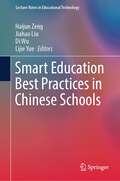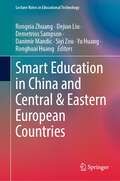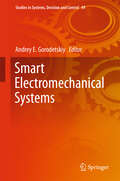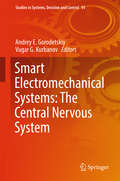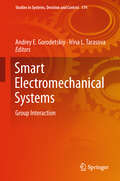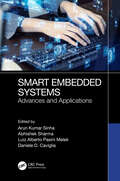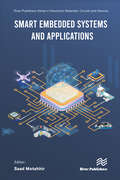- Table View
- List View
Smart Design, Science & Technology: Proceedings of the IEEE 6th International Conference on Applied System Innovation (ICASI 2020), November 5-8, 2020, Taitung, Taiwan (Smart Science, Design & Technology)
by Artde Donald Kin-Tak Lam Stephen D. Prior Siu-Sen Shen Sheng-Joue Young Liang-Wen JiSmart Design, Science & Technology represents the proceedings of the IEEE 6th International Conference on Applied System Innovation (ICASI 2020), which was held in Taitung, Taiwan November 5-8, 2020. The conference received more than 200 submitted papers from at least 11 different countries, whereby roughly one third of these papers was selected by the committees and invited to present at ICASI 2020. This book aims to provide an integrated communication platform for researchers from a wide range of disciplines including information technology, communication science, applied mathematics, computer science, advanced material science, and engineering. Only high quality papers were allowed to publish in the volume. Hopefully, interdisciplinary collaborations between science and engineering technologists in academia and industry will be enhanced via this unique international network.
Smart Device Recognition: Ubiquitous Electric Internet of Things
by Hui Liu Chengming Yu Haiping WuThe book is the first international reference on the field of smart device recognition and Ubiquitous Electric Internet of Things (UEIOT). It presents a range of state-of-the-art key methods and applications for smart device recognition. In future smart environments, obtaining energy consumption information for identifying every device is an effective approach to guarantee the energy efficiency of smart industrial systems. Such as, the Ubiquitous Electric Internet of Things (UEIOT) technology represents one of the most effective measures for electricity and energy management and has attracted considerable attention from scientists and engineers around the world. The realization of smart device recognition in the UEIOT framework has become the core and basis of UEIOT’s success. The device smart recognition can help governments and managers to distribute energy and power better, and help device manufacturers to improve their products regarding smart energy conservation. Accordingly, in the future smart industry, implementing smart device recognition is desired and very important. In the book, several methods, strategies, and experiments for achieving smart device recognition are presented in details. As the first monograph in the field of smart device recognition, the book can provide beneficial reference for students, engineers, scientists, and managers in the fields of power, energy, electromechanical devices, smart cities, artificial intelligence, etc.
Smart Device to Smart Device Communication
by Shahid Mumtaz Jonathan RodriguezThis book presents a comprehensive analysis of D2D communication over LTE-A band. The book uses 3GPP LTE-A as a baseline and explains all fundamental requirements for deploying D2D network under cellular systems from an architectural, technical and business point of view. The contributors explain the standardization activities of Release 12 of LTE-A, which has been recently acknowledged as support of D2D communication in LTE-A. The text updates the research community on the D2D roadmap as well as new features emerging for consideration in 3GPP.
Smart Distributed Embedded Systems for Healthcare Applications (Explainable AI (XAI) for Engineering Applications)
by Preeti Nagrath Jafar A. Alzubi Bhawna Singla Joel J. P. C. Rodrigues A. K. VermaThis book discusses the applications and optimization of emerging smart technologies in the field of healthcare. It further explains different modeling scenarios of the latest technologies in the healthcare system and compares the results to better understand the nature and progress of diseases in the human body, which would ultimately lead to early diagnosis and better treatment and cure of diseases with the help of distributed technology. Covers the implementation models using technologies such as artificial intelligence, machine learning, and deep learning with distributed systems for better diagnosis and treatment of diseases. Gives in-depth review of technological advancements like advanced sensing technologies such as plasmonic sensors, usage of RFIDs, and electronic diagnostic tools in the field of healthcare engineering. Discusses possibilities of augmented reality and virtual reality interventions for providing unique solutions in medical science, clinical research, psychology, and neurological disorders. Highlights the future challenges and risks involved in the application of smart technologies such as cloud computing, fog computing, IOT, and distributed computing in healthcare. Confers to utilize the AI and ML and associated aids in healthcare sectors in the post-Covid 19 period to revitalize the medical setup. Contributions included in the book will motivate technological developers and researchers to develop new algorithms and protocols in the healthcare field. It will serve as a vast platform for gaining knowledge regarding healthcare delivery, health- care management, healthcare in governance, and health monitoring approaches using distributed environments. It will serve as an ideal reference text for graduate students and researchers in diverse engineering fields including electrical, electronics and communication, computer, and biomedical fields.
Smart Distributed Embedded Systems for Healthcare Applications (Explainable AI (XAI) for Engineering Applications)
This book discusses the applications and optimization of emerging smart technologies in the field of healthcare. It further explains different modeling scenarios of the latest technologies in the healthcare system and compares the results to better understand the nature and progress of diseases in the human body, which would ultimately lead to early diagnosis and better treatment and cure of diseases with the help of distributed technology. Covers the implementation models using technologies such as artificial intelligence, machine learning, and deep learning with distributed systems for better diagnosis and treatment of diseases. Gives in-depth review of technological advancements like advanced sensing technologies such as plasmonic sensors, usage of RFIDs, and electronic diagnostic tools in the field of healthcare engineering. Discusses possibilities of augmented reality and virtual reality interventions for providing unique solutions in medical science, clinical research, psychology, and neurological disorders. Highlights the future challenges and risks involved in the application of smart technologies such as cloud computing, fog computing, IOT, and distributed computing in healthcare. Confers to utilize the AI and ML and associated aids in healthcare sectors in the post-Covid 19 period to revitalize the medical setup. Contributions included in the book will motivate technological developers and researchers to develop new algorithms and protocols in the healthcare field. It will serve as a vast platform for gaining knowledge regarding healthcare delivery, health- care management, healthcare in governance, and health monitoring approaches using distributed environments. It will serve as an ideal reference text for graduate students and researchers in diverse engineering fields including electrical, electronics and communication, computer, and biomedical fields.
Smart Driver Training Simulation: Save Money. Prevent.
by Wolf Dieter KäpplerAs technology improves, so does the sophistication of driving simulators. Meanwhile, as the volume of traffic increases, simulators are being seen as a real addition to the driving trainer’s armory. This book explains the basics of education and training using simulators and their ability to improve safety on our streets. Käppler shows that they can be used for documentation, data acquisition, data analysis, evaluation, and modeling as well as for simple training.
Smart Edge Computing: An Operation Research Perspective
by Rajdeep Chakraborty Anupam Ghosh Jyotsna Kumar Mandal Tanupriya Choudhury Prasenjit ChatterjeeThis book pioneers the synergy between state-of-the-art edge computing technologies and the power of operations research. It comprehensively explores real-world applications, demonstrating how various operations' research techniques enhance edge computing’s efficiency, reliability and resource allocation. Innovative solutions for dynamic task scheduling, load balancing and data management, all tailored to the unique challenges of edge environments, are displayed. Starting with operation research methodologies with foundations, applications and research challenges in edge computing and an overview of digital education, this book continues with an exploration of applications in the health sector using IoT, intelligent payment procedures and performance measurement of edge computing, using edge computing and operation research. Smart or AI-based applications are also explored further on and the book ends with insight into ultralightweight and security protocols with solutions for IoT using blockchain.
Smart Edge Computing: An Operation Research Perspective
by Rajdeep Chakraborty Anupam Ghosh Jyotsna Kumar Mandal Tanupriya Choudhury Prasenjit ChatterjeeThis book pioneers the synergy between state-of-the-art edge computing technologies and the power of operations research. It comprehensively explores real-world applications, demonstrating how various operations' research techniques enhance edge computing’s efficiency, reliability and resource allocation. Innovative solutions for dynamic task scheduling, load balancing and data management, all tailored to the unique challenges of edge environments, are displayed. Starting with operation research methodologies with foundations, applications and research challenges in edge computing and an overview of digital education, this book continues with an exploration of applications in the health sector using IoT, intelligent payment procedures and performance measurement of edge computing, using edge computing and operation research. Smart or AI-based applications are also explored further on and the book ends with insight into ultralightweight and security protocols with solutions for IoT using blockchain.
Smart Education and e-Learning 2016 (Smart Innovation, Systems and Technologies #59)
by Vladimir L. Uskov Robert J. Howlett Lakhmi C. JainThis book contains the contributions presented at the 3rd international KES conference on Smart Education and Smart e-Learning, which took place in Puerto de la Cruz, Tenerife, Spain, June 15-17, 2016. It contains a total of 56 peer-reviewed book chapters that are grouped into several parts: Part 1 - Smart University: Conceptual Modeling, Part 2 – Smart Education: Research and Case Studies, Part 3 – Smart e-Learning, Part 4 – Smart Education: Software and Hardware Systems, and Part 5 – Smart Technology as a Resource to Improve Education and Professional Training. We believe that the book will serve as a useful source of research data and valuable information for faculty, scholars, Ph.D. students, administrators, and practitioners - those who are interested in innovative areas of smart education and smart e-learning.
Smart Education and e-Learning 2017 (Smart Innovation, Systems and Technologies #75)
by Vladimir L. Uskov Robert J. Howlett Lakhmi C. JainThis book gathers the contributions presented at the 4th International KES Conference on Smart Education and Smart e-Learning (KES-SEEL-17), which took place in Vilamoura, Algarve, Portugal, June 21–23, 2017. Smart education and smart e-Learning are emerging and rapidly growing areas. They represent the innovative integration of smart systems, technologies and objects, smart environments, smart pedagogy, smart learning and academic analytics, various branches of computer science and computer engineering, and state-of-the-art smart educational software and/or hardware systems. It contains a total of 48 peer-reviewed book chapters that are grouped into several parts: Part 1 – Smart Pedagogy, Part 2 – Smart e-Learning, Part 3 – Systems and Technologies for Smart Education, Part 4 – Smart Teaching, and Part 5 – Smart Education: National Initiatives and Approaches. The book offers a valuable source of research data, information on best practices, and case studies for educators, researchers, Ph.D. students, administrators, and practitioners—and all those who are interested in innovative areas of smart education and smart e-Learning.
Smart Education and e-Learning 2018: Proceedings Of The 5th International Kes Conference On Smart Education And E-learning (kes-seel-18) (Smart Innovation, Systems and Technologies #99)
by Vladimir L. Uskov Robert J. Howlett Lakhmi C. Jain Ljubo VlacicThis book features the contributions presented at the 5th International KES Conference on Smart Education and e-Learning, which took place in Gold Coast, Australia, June 20–22, 2018. The peer-reviewed papers are grouped into several interconnected parts: Part 1 – Smart Education: Systems and Technology, Part 2 – Smart Pedagogy, Part 3 – Smart Education: Case Studies and Research, and Part 4: Sustainable Learning Technologies: Smart Higher Education Futures. Smart education and smart e-learning are emerging and rapidly growing areas with the potential to transform existing teaching strategies, learning environments, and educational activities and technology in the classroom. Smart education and smart e-learning focus on enabling instructors to develop new ways of achieving excellence in teaching in highly technological smart classrooms, and providing students with new opportunities to maximize their success and select the best options for their education, location and learning style, as well as the mode of content delivery. This book serves as a useful source of research data and valuable information on current research projects, best practices and case studies for faculty, scholars, Ph.D. students, administrators, and practitioners – all those who are interested in smart education and smart e-learning.
Smart Education and e-Learning 2019 (Smart Innovation, Systems and Technologies #144)
by Lakhmi C. Jain Robert J. Howlett Vladimir L. UskovThis book contains the contributions presented at the 6th international KES conference on Smart Education and e-Learning (KES SEEL-2019), which took place at St. Julian’s, Malta, June 17–19, 2019. It contains fifty-five high-quality peer-reviewed papers that are grouped into several interconnected parts: Part 1 – Smart Education, Part 2 – Smart e-Learning, Part 3 – Smart Pedagogy, Part 4 – Smart Education: Systems and Technology, Part 5 – Smart Education: Case Studies and Research, Part 6 – Students with Disabilities and Smart Education/University, and Part 7 – Mathematical Modelling of Smart Education and Economics of Smart University. Smart education and smart e-learning are emerging and rapidly growing areas with the potential to transform existing teaching strategies, learning environments, and educational activities and technology in the classroom. Smart education and smart e-learning focus on enabling instructors to develop new ways of achieving excellence in teaching in highly technological smart classrooms, and providing students with new opportunities to maximize their success and select the best options for their education, location and learning style, as well as the mode of content delivery. This book serves as a useful source of research data and valuable information on current research projects, best practices and case studies for faculty, scholars, Ph.D. students, administrators, and practitioners – all those who are interested in smart education and smart e-learning.
Smart Education and e-Learning 2020: Proceedings Of The 7th International Kes Conference On Smart Education And E-learning (kes Seel-2020) (Smart Innovation, Systems and Technologies #188)
by Vladimir L. Uskov Robert J. Howlett Lakhmi C. JainThis book contains the contributions presented at the 7th international KES conference on Smart Education and e-Learning (KES SEEL-2020), which being held as a virtual conference on June 17-19, 2020. It contains fifty three high quality peer-reviewed papers that are grouped into several interconnected parts: Part 1 – Smart Education, Part 2 – Smart e-Learning, Part 3 – Smart Pedagogy, Part 4 - Smart Education: Systems and Technology, Part 5 – Smart Education: Case Studies and Research, Part 6 - Smart University Development: Organizational and Managerial Issues, Part 7 - Smart Education and Smart Universities and their Impact on Students with Disabilities, Part 8 - Mathematical Models in Smart Education and e-Learning, and Part 9 - Models of Professional Practice in Higher Education.Smart education and smart e-learning are emerging and rapidly growing areas with the potential to transform existing teaching strategies, learning environments, and educational activities and technology in the classroom. Smart education and smart e-learning focus on enabling instructors to develop new ways of achieving excellence in teaching in highly technological smart classrooms, and providing students with new opportunities to maximize their success and select the best options for their education, location and learning style, as well as the mode of content delivery. This book serves as a useful source of research data and valuable information on current research projects, best practices and case studies for faculty, scholars, Ph.D. students, administrators, and practitioners – all those who are interested in smart education and smart e-learning.
Smart Education and e-Learning 2021 (Smart Innovation, Systems and Technologies #240)
by Lakhmi C. Jain Robert J. Howlett Vladimir L. UskovThis book contains the contributions presented at the 8th International KES Conference on Smart Education and e-Learning (KES SEEL 2021), which being held as a virtual conference on June 14–16, 2021. It contains high-quality peer-reviewed papers that are grouped into several interconnected parts: smart education; smart e-learning; smart education: systems and technology; smart education: case studies and research; digital education and economics in smart university, smart university development: organizational, managerial and social Issues; smart universities and their Impact on students with disabilities. This book serves as a useful source of research data and valuable information on current research projects, best practices, and case studies for faculty, scholars, Ph.D. students, administrators, and practitioners— all those who are interested in smart education and smart e-learning.
Smart Education and e-Learning - Smart Pedagogy (Smart Innovation, Systems and Technologies #305)
by Vladimir L. Uskov Robert J. Howlett Lakhmi C. JainThis book serves as a reference for researchers and practitioners in academia and industry. Smart education, smart e-learning and smart pedagogy are emerging and rapidly growing areas that have a potential to transform existing teaching strategies, learning environments and educational activities and technology. They are focused at enabling instructors to develop innovative ways of achieving excellence in teaching in highly technological smart university and providing students with new opportunities to maximize their success using smart classrooms, smart systems and technology. This book contains the contributions presented at the 9th international KES conference on Smart Education and e-Learning (SEEL-2022) with the Smart Pedagogy as the main conference theme. It comprises of forty nine high-quality peer-reviewed papers that are grouped into several interconnected parts: Part 1—Smart Pedagogy, Part 2—Smart Education, Part 3—Smart e-Learning, Part 4—Smart University, Part 5—Smart Education: Systems and Technology, Part 6—Digital Humanities and Social Sciences for Smart University Development: the Innovative Methods, Models and Technologies, Part 7—Digital Transformation of Education and Economics in Smart University and Part 8—Smart Education for Children with Special Educational Needs. We believe this book will serve as a useful source of research data and valuable information for faculty, scholars, Ph.D. students, administrators and practitioners—those who are interested in smart education, smart e-learning and smart pedagogy.
Smart Education and e-Learning—Smart University: Proceedings of the 10th International Conference on Smart Education and e-Learning (KES SEEL-2023) (Smart Innovation, Systems and Technologies #355)
by Vladimir L. Uskov Robert J. Howlett Lakhmi C. JainThis book contains the contributions presented at the 10th international KES conference on Smart Education and e-Learning (SEEL-2023) with the Smart University as the main conference theme. The conference is being held on June 14-16, 2023 in Rome, Italy in both in-person and online modes. The book contains high quality peer-reviewed papers that are grouped into several interconnected parts: Part 1 – Smart Education, Part 2 – Smart e-Learning, Part 3 – Smart University, Part 4 – Smart Education: Case Studies and Research, and Part 5 – Smart Company: Case Studies and Research. Smart education, smart e-learning, smart universities and smart companies are emerging and rapidly growing areas with the potential to transform the existing teaching strategies, learning environments, and educational/training activities and technology in academic institutions and training centers. Smart education/training and smart e-learning are focused on enabling instructors/trainers to develop innovative ways of achieving excellence in teaching in highly technological smart classrooms/labs, and providing students/learners with new opportunities to maximize their success and select the best options for their education/training, location and learning style, as well as the mode of content delivery. This book serves as a useful source of research data and valuable information on current research projects, best practices and case studies for faculty, scholars, Ph.D. students, administrators, and practitioners – all those who are interested in smart education, smart e-learning, smart university and smart business/company paradigms, concepts, systems and technology.
Smart Education and Smart e-Learning: Proceedings Of The 5th International Kes Conference On Smart Education And E-learning (kes-seel-18) (Smart Innovation, Systems and Technologies #41)
by Vladimir L. Uskov Robert J. Howlett Lakhmi C. JainThis book contains the contributions presented at the 2nd international KES conference on Smart Education and Smart e-Learning, which took place in Sorrento, Italy, June 17-19, 2015. It contains a total of 45 peer-reviewed book chapters that are grouped into several parts: Part 1 - Smart Education, Part 2 – Smart Educational Technology, Part 3 – Smart e-Learning, Part 4 – Smart Professional Training and Teachers’ Education, and Part 5 – Smart Teaching and Training related Topics. This book can be a useful source of research data and valuable information for faculty, scholars, Ph.D. students, administrators, and practitioners - those who are interested in innovative areas of smart education and smart e-learning.
Smart Education Best Practices in Chinese Schools (Lecture Notes in Educational Technology)
by Haijun Zeng Jiahao Liu Di Wu Lijie YueThis book presents 28 practical case studies in detail and 49 case studies in brief. The collection of these case studies focuses on one or more aspects of exploration and practice on the following topics: smart campus and smart classroom, resource construction and sharing, new teaching mode, comprehensive quality evaluation of students, teacher professional development, application of teaching platform and tool, innovative application of online learning space, collaborative education, and school management and services. The selection and evaluation criteria of the case studies on school practice mainly include concept and implementation, effectiveness and characteristics, innovation and demonstration, and expression and structure. This book helps readers gain a rich understanding of the diverse innovative implementation of smart education in Chinese schools and inspires smart education development in schools in other countries.
Smart Education in China and Central & Eastern European Countries (Lecture Notes in Educational Technology)
by Rongxia Zhuang Dejian Liu Demetrios Sampson Danimir Mandic Siyi Zou Yu Huang Ronghuai HuangThis book focuses on the development of smart education in China and some countries of Central and Eastern Europe. A brief discussion on the idea of smart education was given in the introduction chapter, followed by a series of national smart education profiles of eleven countries. In detail, the profile starts with an overview of ICT in Education or smart education in the country and policies of ICT in Education or smart education. Some key features of smart education in each country were discussed with examples of best practices. The profile ends with a description of trends of smart education in the country. Based on the information above, the final chapter presents an analysis among the eleven countries with six major features they presented and concluded the book with suggestions on advancing smart education by three points.
Smart Electromechanical Systems: Group Interaction (Studies in Systems, Decision and Control #49)
by Andrey E. GorodetskiyThis carefully edited book introduces the latest achievements of the scientists of the Russian Academy of Sciences in the field of theory and practice of Smart Electromechanical Systems (SEMS). The book also focuses on methods of designing and modeling of SEMS based on the principles of adaptability, intelligence, biomorphism of parallel kinematics and parallelism in information processing and control computation. The book chapters are dedicated to the following points of interest: - methods of design of SEMS modules and intelligent robots based on them; - synthesis of neural systems of automatic control over SEMS modules; - mathematical and computer modeling of SEMS modules and Cyber Physical Systems based on them; - vitality control and reliability analysis based on logic-and-probabilistic and logic-and-linguistic forecasting; - methods of optimization of SEMS control systems based on mathematical programming methods in ordinal scale and generalized mathematical programming; - information-measuring software of SEMS modules and CPS based on them. This book is intended for students, scientists and engineers specializing in the field of SEMS and robotics, and includes many scientific domains such as kinematics, dynamics, control theory.
Smart Electromechanical Systems: The Central Nervous System (Studies in Systems, Decision and Control #95)
by Andrey E. Gorodetskiy Vugar G. KurbanovThis book describes approaches to solving the problems of developing the central nervous system of robots (CNSR) based on smart electromechanical systems (SEMS) modules, principles of construction of the various modules of the central nervous system and variants of mathematical software CNSR in control systems for intelligent robots. It presents the latest advances in theory and practice at the Russian Academy of Sciences. Developers of intelligent robots to solve modern problems in robotics are increasingly addressing the use of the bionic approach to create robots that mimic the complexity and adaptability of biological systems. These have smart electromechanical system (SEMS), which are used in various cyber-physical systems (CPhS), and allow the functions of calculation, control, communications, information storage, monitoring, measurement and control of parameters and environmental parameters to be integrated. The behavior of such systems is based on the information received from the central nervous system of the robot (CNSR) on the state of the environment and system state. Recent advances in computer science, measuring and computing techniques have stimulated the practical realization of the CNSR, providing a fundamentally new approach to the methods and algorithms of formation of appropriate robot behavior. Intelligent robots with CNSR occupy a special place among the highly efficient robotic systems with parallel structures and play an important role in modern automated industries, and this timely book is a valuable resource for specialists in the field of robotics and control, as well as for students majoring in “Robots”, “System analysis and management”, and “Automation and control”.
Smart Electromechanical Systems: Group Interaction (Studies in Systems, Decision and Control #49)
by Andrey E. Gorodetskiy Irina L. TarasovaThis book presents the latest achievements in the theory and practice of SEMS Group interaction by scientists from the Russian Academy of Sciences. It also discusses the development of methods for the design and simulation of SEMS Group interaction based on the principles of safety, flexibility and adaptability in behavior and intelligence and parallelism in information processing, computation and control. Recently, the task has been to ensure the functioning of robots within the framework of collective collaboration, so that they function efficiently, reliably and safely in real time. The topics covered include, but are not limited to, the following: - the planning behavior of the SEMS group;- methods and principles of designing of automatic control systems;- mathematical and computer modeling group interaction;- safety, flexibility and adaptability of the SEMS Group;- information-measuring soft- and hardware. This book is intended for students, scientists and engineers specializing in the field of smart electromechanical systems and robotics.
Smart Embedded Systems: Advances and Applications
by Arun Kumar Sinha Abhishek Sharma Luiz Alberto Pasini Melek Daniele D. Caviglia"Smart Embedded Systems: Advances and Applications" is a comprehensive guide that demystifies the complex world of embedded technology. The book journeys through a wide range of topics from healthcare to energy management, autonomous robotics, and wireless communication, showcasing the transformative potential of intelligent embedded systems in these fields. This concise volume introduces readers to innovative techniques and their practical applications, offers a comparative analysis of wireless protocols, and provides efficient resource allocation strategies in IoT-based ecosystems. With real-world examples and in-depth case studies, it serves as an invaluable resource for students and professionals seeking to harness the power of embedded technology to shape our digital future. Salient Features: 1. The book provides a comprehensive coverage of various aspects of smart embedded systems, exploring their design, implementation, optimization, and a range of applications. This is further enhanced by in-depth discussions on hardware and software optimizations aimed at improving overall system performance. 2. A detailed examination of machine learning techniques specifically tailored for data analysis and prediction within embedded systems. This complements the exploration of cutting-edge research on the use of AI to enhance wireless communications. 3. Real-world applications of these technologies are extensively discussed, with a focus on areas such as seizure detection, noise reduction, health monitoring, diabetic care, autonomous vehicles, and communication systems. This includes a deep-dive into different wireless protocols utilized for data transfer in IoT systems. 4. This book highlights key IoT technologies and their myriad applications, extending from environmental data collection to health monitoring. This is underscored by case studies on the integration of AI and IoT in healthcare, spanning topics from anomaly detection to informed clinical decision-making. Also featured is a detailed evaluation and comparison of different system implementations and methodologies. This book is an essential read for anyone interested in the field of embedded systems. Whether you're a student looking to broaden your knowledge base, researchers looking in-depth insights, or professionals planning to use this cutting-edge technology in real-world applications, this book offers a thorough grounding in the subject.
Smart Embedded Systems: Advances and Applications
"Smart Embedded Systems: Advances and Applications" is a comprehensive guide that demystifies the complex world of embedded technology. The book journeys through a wide range of topics from healthcare to energy management, autonomous robotics, and wireless communication, showcasing the transformative potential of intelligent embedded systems in these fields. This concise volume introduces readers to innovative techniques and their practical applications, offers a comparative analysis of wireless protocols, and provides efficient resource allocation strategies in IoT-based ecosystems. With real-world examples and in-depth case studies, it serves as an invaluable resource for students and professionals seeking to harness the power of embedded technology to shape our digital future. Salient Features: 1. The book provides a comprehensive coverage of various aspects of smart embedded systems, exploring their design, implementation, optimization, and a range of applications. This is further enhanced by in-depth discussions on hardware and software optimizations aimed at improving overall system performance. 2. A detailed examination of machine learning techniques specifically tailored for data analysis and prediction within embedded systems. This complements the exploration of cutting-edge research on the use of AI to enhance wireless communications. 3. Real-world applications of these technologies are extensively discussed, with a focus on areas such as seizure detection, noise reduction, health monitoring, diabetic care, autonomous vehicles, and communication systems. This includes a deep-dive into different wireless protocols utilized for data transfer in IoT systems. 4. This book highlights key IoT technologies and their myriad applications, extending from environmental data collection to health monitoring. This is underscored by case studies on the integration of AI and IoT in healthcare, spanning topics from anomaly detection to informed clinical decision-making. Also featured is a detailed evaluation and comparison of different system implementations and methodologies. This book is an essential read for anyone interested in the field of embedded systems. Whether you're a student looking to broaden your knowledge base, researchers looking in-depth insights, or professionals planning to use this cutting-edge technology in real-world applications, this book offers a thorough grounding in the subject.
Smart Embedded Systems and Applications
by Saad MotahhirThis book covers a wide range of challenges, technologies and state-of-the-art for the design, development and realization of smart and complex embedded systems and their applications; i.e., software and hardware development, with the use of digital technologies, and quality assurance for critical applications. This book starts with automotive safety systems which is one of the major functional domains. It discusses the importance of software in automotive systems followed by an insight into Automotive Software Standards, ISO26262, and Autosar. The book further discusses the use of Processor in the loop test for an adaptive trajectory tracking control for quadrotor UAVs. It also illustrates the role of embedded systems in medical engineering. Various innovative applications involving the concept of image processing and Internet of Things are also presented in this book. The SoC Power Estimation is also investigated. Finally, a Review of the Hardware/Software Partitioning Algorithms with some future works have been presented. this book is intended for academicians, researchers, and industrialists.

